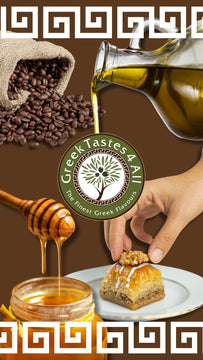Have Questions?Ask An Expert
Greek Pickled Gherkins 670g, Glass Jar.
Trustify review stars will be displayed here!
-
Nestos, Greek Pickled Gherkins, Net Weight 670g, Glass Jar. Mediterranean Delicacy :
Modern culinary proposals, reassessing old humble techniques, discover dishes and food for one more time, which, in pickle form, become delicious appetizers.
Pickle is a way of maintaining vegetables, and vinegar plays a key role. It is said that the method of preserving food with vinegar was discovered 4000 years ago, and originally clay pots were used, while the process began to spread widely in Europe in the 16th century. Properly mixing spices, sugar and vinegar with vegetables is the secret that gives them a crispy texture and strong sour taste and keeps them tight. Pickles gherkins are low in calories, contain no fat and are one of the oldest dishes.
The gherkin pickle of the "Barba Yianni" estate is a proposal that will fascinate you. The fertile Greek land, but mainly the passion and love of the people for nutritious and delicious products, led to the production of an excellent taste and rich nutritional value proposition. The cucumber is a vegetable widely cultivated, containing a plurality of nutrients (vitamins A and C) and minerals such as calcium, potassium, manganese, and sulfur, which help to regulate blood pressure and maintain healthy hair and nails. Also, it is composed of water in 96%, which enhances its diuretic effect and is ideal for diet.
Collecting the appropriate cucumbers for the preparation of pickles is being done by hand, selecting only the perfect fruit. Then, in the modern facilities of the NESTOS SA company, which are certified with all the quality assurance standards, the process of preparing the pickle is completed.
Serve with Greek pickles, your starters, your daily dishes, burgers, or potato salads. It will be a tasty proposition that will be noted!
Keep it in a cool and dry place. Keep refrigerated after opening.
-
Ingredients:
- Gherkins,
- Water,
- Vinegar,
- Salt,
- Sugar,
- Mustard seeds,
- Herbs & Spices.
Composition per 100gr:
- Calories 32 kcal
- Fat 0.1 g.
- Proteins 1.1 g.
- Carbohydrates 7.2g.
- Water 208 g.
- Sodium 90,9 mg
- Potassium 43 mg
- Iron 0,5 mg
- Calcium 14 mg
- Phosphorus 23 mg
-
Certified by ISO 22000 and HACCP Quality Assurance.
Subcribe to back in stock notification
-
Nestos, Greek Pickled Gherkins, Net Weight 670g, Glass Jar. Mediterranean Delicacy :
Modern culinary proposals, reassessing old humble techniques, discover dishes and food for one more time, which, in pickle form, become delicious appetizers.
Pickle is a way of maintaining vegetables, and vinegar plays a key role. It is said that the method of preserving food with vinegar was discovered 4000 years ago, and originally clay pots were used, while the process began to spread widely in Europe in the 16th century. Properly mixing spices, sugar and vinegar with vegetables is the secret that gives them a crispy texture and strong sour taste and keeps them tight. Pickles gherkins are low in calories, contain no fat and are one of the oldest dishes.
The gherkin pickle of the "Barba Yianni" estate is a proposal that will fascinate you. The fertile Greek land, but mainly the passion and love of the people for nutritious and delicious products, led to the production of an excellent taste and rich nutritional value proposition. The cucumber is a vegetable widely cultivated, containing a plurality of nutrients (vitamins A and C) and minerals such as calcium, potassium, manganese, and sulfur, which help to regulate blood pressure and maintain healthy hair and nails. Also, it is composed of water in 96%, which enhances its diuretic effect and is ideal for diet.
Collecting the appropriate cucumbers for the preparation of pickles is being done by hand, selecting only the perfect fruit. Then, in the modern facilities of the NESTOS SA company, which are certified with all the quality assurance standards, the process of preparing the pickle is completed.
Serve with Greek pickles, your starters, your daily dishes, burgers, or potato salads. It will be a tasty proposition that will be noted!
Keep it in a cool and dry place. Keep refrigerated after opening.
-
Ingredients:
- Gherkins,
- Water,
- Vinegar,
- Salt,
- Sugar,
- Mustard seeds,
- Herbs & Spices.
Composition per 100gr:
- Calories 32 kcal
- Fat 0.1 g.
- Proteins 1.1 g.
- Carbohydrates 7.2g.
- Water 208 g.
- Sodium 90,9 mg
- Potassium 43 mg
- Iron 0,5 mg
- Calcium 14 mg
- Phosphorus 23 mg
-
Certified by ISO 22000 and HACCP Quality Assurance.
RETURNS POLICY
Lorem ipsum dolor sit amet, consectetur adipiscing elit. Morbi ut blandit risus. Donec mollis nec tellus et rutrum. Orci varius natoque penatibus et magnis dis parturient montes, nascetur ridiculus mus. Ut consequat quam a purus faucibus scelerisque. Mauris ac dui ante. Pellentesque congue porttitor tempus. Donec sodales dapibus urna sed dictum. Duis congue posuere libero, a aliquam est porta quis.
Donec ullamcorper magna enim, vitae fermentum turpis elementum quis. Interdum et malesuada fames ac ante ipsum primis in faucibus.
Curabitur vel sem mi. Proin in lobortis ipsum. Aliquam rutrum tempor ex ac rutrum. Maecenas nunc nulla, placerat at eleifend in, viverra etos sem. Nam sagittis lacus metus, dignissim blandit magna euismod eget. Suspendisse a nisl lacus. Phasellus eget augue tincidunt, sollicitudin lectus sed, convallis desto. Pellentesque vitae dui lacinia, venenatis erat sit amet, fringilla felis. Nullam maximus nisi nec mi facilisis.
SHIPPING
Lorem ipsum dolor sit amet, consectetur adipiscing elit. Morbi ut blandit risus. Donec mollis nec tellus et rutrum. Orci varius natoque penatibus et magnis dis parturient montes, nascetur ridiculus mus. Ut consequat quam a purus faucibus scelerisque. Mauris ac dui ante. Pellentesque congue porttitor tempus. Donec sodales dapibus urna sed dictum. Duis congue posuere libero, a aliquam est porta quis.
Donec ullamcorper magna enim, vitae fermentum turpis elementum quis. Interdum et malesuada fames ac ante ipsum primis in faucibus.
Curabitur vel sem mi. Proin in lobortis ipsum. Aliquam rutrum tempor ex ac rutrum. Maecenas nunc nulla, placerat at eleifend in, viverra etos sem. Nam sagittis lacus metus, dignissim blandit magna euismod eget. Suspendisse a nisl lacus. Phasellus eget augue tincidunt, sollicitudin lectus sed, convallis desto. Pellentesque vitae dui lacinia, venenatis erat sit amet, fringilla felis. Nullam maximus nisi nec mi facilisis.

























